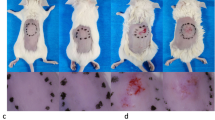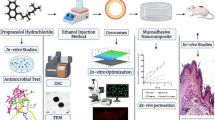Abstract
The first phase of the healing process is characterized by the development of an inflammatory reaction involving migration of inflammatory cells and release of inflammatory mediators. In a previous study, we have demonstrated that the water soluble tetrachlorodecaoxygen complex (TCDO), first synthetized to promote wound healing, inhibits polymorphonuclear (PMN) migration. The aim of the present study was to investigate the activity of TCDO on the progression of an acute non-specific inflammatory reaction, on the release of 6-keto-PGF1α and PGE2 and on PMN oxidative metabolism in the rat.
Injected in the pleural cavity, TCDO (15 μmoles/rat) significantly decreased the number of exudative cells while 1.5 μmoles/rat inhibited PMN oxidative metabolismex vivo (assessed by chemiluminescent assay and measurement of O −2 generation) after stimulation of the cells by opsonized zymosan. Similar observations were madein vitro after incubation of PMNs with various concentrations of TCDO (300 to 3 μM). The effect was dose-related and highly significant up to the concentration of 3 μM.
In parallel, TCDO decreased the amounts of 6-keto-PGF1α and PGE2 in exudates harvested 1 hour after the intrapleural injection of isologous serum. Effects were significantly different from control levels, from 1.5 to 0.03 μmoles/rat for 6-keto-PGF1α and from 1.5 to 0.01 μmoles/rat for PGE2.
This effect was observed when TCDO was injected at the same time or 1 hour before the isologous serum but not later.
TCDO also inhibited LTB4 generationin vitro after PMN stimulation by calcium ionophore A23187, at concentrations up to 150 μM.
The effects of TCDOin vivo andin vitro on rat PMN functions and inflammatory mediator release mimic certain activities of anti-inflammatory drugs. These properties may be beneficial in the very early stages of the wound healing process.
Similar content being viewed by others
References
J. Hinz, H. Hantzinger, J. Helling, G. Shirren, G. Sell, K. W. Stahl and F. W. Kühne,Stimulation der Wundheilung durch TCDO: Ergebnisse einer randomisierten Doppelblindstudie. Fortschr. Med.18, 523–528 (1984).
J. Hinz, F. W. Kühne and K. W. Stahl,Local tetrachlorodecaoxide treatment to improve supply to non-healing wounds. The Lancet sept.15, 630–632 (1984).
G. Woerly, Y. Lombard, K. W. Stahl and P. Poindron,Capacity of Tetrachlorodecaoxygen anion complex and bacteria lipopolysaccharide to accelerate phagocytosis of subculturea normal mouse resident macrophages. Hematol. Rev. and Comm. conf. [Suppl. 1], p. 81 (1986).
G. Gillisen, F. W. Kühne, M. Breuer-Werle, B. Melzer and H. Ostendorp,Increased resistance towards two systemic experimental infections by Tetrachlorodecaoxygen anion complex. Arzneim. Forsh./Drug. Res.36, 1778–1782 (1986).
H. L. Malech and J. I. Gallin,Current concepts: Immunology neutrophils in human diseases. New Engl. J. Med.317, 687–694 (1987).
I. M. Goldstein,Agents that interfere with arachidonic acid metabolism. InInflammation, basic principles and clinical correlates. (Eds. J. I. Gallin, I. M. Goldstein and R. Snyderman) pp. 935–946. Raven Pres, New York 1988.
M. Roch-Arveiller and K. W. Stahl,Tetrachlorodecaoxygen anion complex (TCDO): a novel oxidant used for wound healing promotion inhibits PMN chemotaxis and extravasation. Arth. Rheum. Council for Research, Proc. “The control of Tissue Damage” Cambridge 6–8 april, pp. 135–136 (1987).
J. P. Giroud, M. Roch-Arveiller and O. Muntaner,Prélèvement répété des polynucléaires dand la cavité pleurale, application à l'étude du chimiotactisme. Nelle. Rev. Fse. Hematol.20, 535–543 (1978).
F. Dray, B. Charbonnel and J. Maclouf,Radioimmunoassay of prostaglandins F., E1 and E2 in human plasma. Eur. J. Clin. Invest.5, 311–318 (1975).
R. C. Allen, R. L. Stjernholm and R. H. Steel,Evidence for the generation of an electronic state(s) in human polymor-phonuclear leukocytes and its participation in bactericidal activity. Biochem. Biophys. Res. Comm.47, 679–684 (1972).
R. Johnston, B. B. Kell, H. P. Misra, J. E. Lehmeyer, L. S. Webb, R. L. Bachner and K. V. Rajacopalan,The role of superoxide anion generation in phagocytic bactericidal activity. J. Clin. Invest.55, 1357–1372 (1975).
S. Abramson, H. Edelson, H. Kaplan, R. Ludewig and G. Weissmann,Inhibition of neutrophil activation by non-steroidal anti-inflammatory drugs. Am. J. Med.77, 3–6 (1984).
S. Abramson, H. Korchak, R. Ludewig, H. Edelson, K. Haines, R. I. Levin, R. Herman, L. Rider, S. Kimmel and G. Weissman,Modes of action of aspirin-like drugs. Proc. Natl. Acad. Sci. (USA)82, 7227–7231 (1985).
T. M. Neal, M. C. M. Vissers and C. C. Winterbourn,Inhibition by non-steroidal anti-inflammatory drugs of superoxide production and granule enzyme release by polymorphonuclear leukocytes stimulated with immune complexes or formyl-methionyl-leucyl-phenylalanine. Biochem. Pharmacol.36, 2511–2517 (1987).
J. C. Gay, J. N. Lukens and D. K. English,Differential inhibition of neutrophil superoxide generation by non-steroidal anti-inflammatory drugs. Inflammation8, 209–222 (1984).
J. R. Vane,Inhibition of prostaglandin synthesis as a mechanism of action of aspirine-like drugs. Nature231, 232–235 (1971).
B. Samuelsson,Leukotrienes: mediators of immediate hypersensitivity reactions and inflammation. Science220, 568–569 (1983).
C. A. Dinarello,Cytokines: interleukin-1 and tumor necrosis factor (Cachectin). InInflammation basic principles and clinical correlates. (Eds. J. I. Gallin, I. M. Goldstein and R. Snyderman) pp. 195–208. Raven Press, New York 1988.
R. F. Myers and M. I. Siegel,Differential effects of anti-inflammatory drugs on lipoxygenase and cyclooxygenase activities of neutrophils from reverse passive Arthus-reaction. Biochem. Biophys. Res. Com.112, 586–594 (1983).
I. Ahnfelt-Rønne and E. Arrigoni-Martelli,Effects of non-steroidal anti-inflammatory agents on arachidonic acid metabolism. Adv. Infl. Res.8, 83–107 (1984).
C. Bertez, M. Miquel, C. Coquelet, D. Sincholle and C. Bonne,Dual inhibition of cyclooxygenase and lipoxygenase by 2-acetylthiophene 2-thiazolhydrazone (CBS-1108) and effect on leukocyte migration in vivo. Biochem. Pharmacol.33, 1757–1762 (1983).
D. Sincholle, C. Bertez, A. Legrand, J. P. Conduzorgues and C. Bonne,Anti-inflammatory activity of a dual inhibitor of cyclooxygenase and lipoxygenase pathways, CBS-1108. Arzneim. Forsch./Drug Res.35, 1260–1263 (1985).
J. P. Heggers and M. C. Robson,Eicosanoids in wound healing. InProstaglandins in clinical practice. (Ed. W. D. Watkins) pp. 183–193. Raven Press, New York 1989.
Author information
Authors and Affiliations
Rights and permissions
About this article
Cite this article
Tissot, M., Roch-Arveiller, M., Mathieu, J. et al. Anti-inflammatory properties of a novel wound healing and immunomodulating agent, tetrachlorodecaoxygen complex (TCDO). Agents and Actions 31, 368–374 (1990). https://doi.org/10.1007/BF01997633
Received:
Accepted:
Issue Date:
DOI: https://doi.org/10.1007/BF01997633




